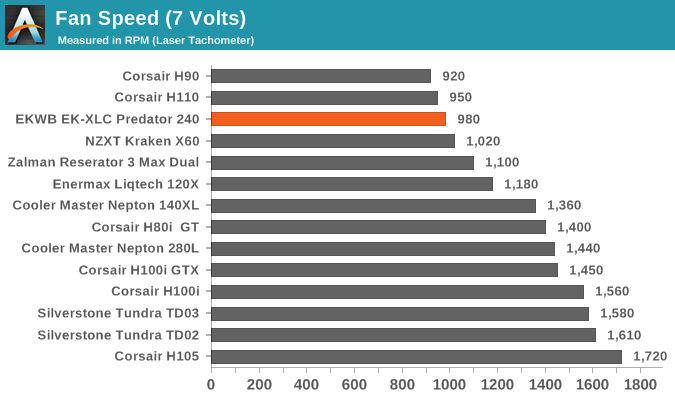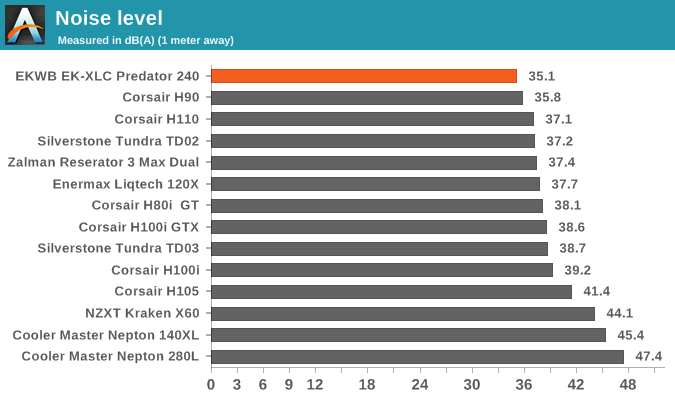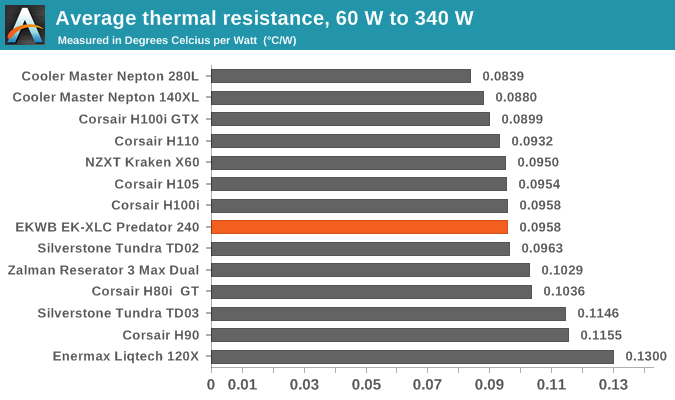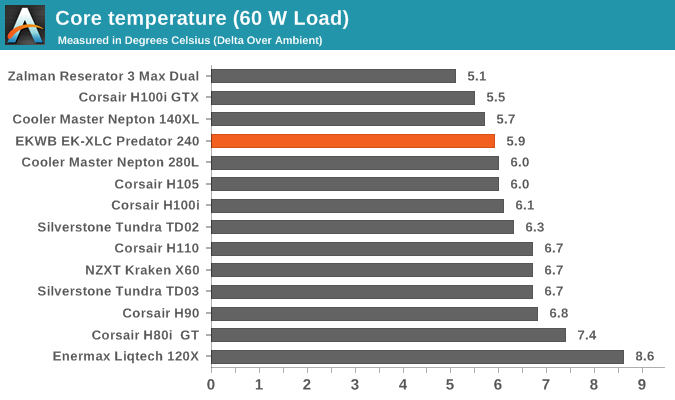The EKWB EK-XLC Predator 240 Liquid Cooler Review
by E. Fylladitakis on December 15, 2015 9:00 AM EST- Posted in
- Cases/Cooling/PSUs
- AIO
- Water Cooling
- Liquid Cooling
- EKWB
Testing results, low fan speed (7 Volts)




| Core Temperature, Constant Thermal Load (Max Fan Speed) |
At first sight, the thermal performance of EK-XLC Predator 240 with a supply of 7 Volts does not appear to be stellar. With an average thermal resistance of 0.0958 °C/W, it falls to the seventh place of the chart and appears at a disadvantage against most other dual fan coolers under heavy loads. The other coolers that are directly on par with its thermal performance are mainly older designs, such as the Corsair H100i and the first revision of SilverStone's TD02. More recent designs, such as the Corsair H100i GTX, and models with dual 140 mm fan radiators, appear to have a notable thermal performance advantage.
The catch is that, under these operating conditions, the EK-XLC Predator 240 is the quietest AIO cooler that we have ever tested to this date. Our instruments recorded just 35.1 dB(A), a barely audible figure that combats even the best low-noise CPU cooler designs. The coolers that displayed significantly greater thermal performance are also much louder. As the dB(A) scale is logarithmic, the pressure triples for every increase of 3 dB(A), so the actual difference in comparison to the top performers is vast.










36 Comments
View All Comments
zeeBomb - Tuesday, December 15, 2015 - link
Awesome coolerHollyDOL - Tuesday, December 15, 2015 - link
So, with a SkyLake, you can cool at about 10°C above ambient at 35dB? That's definitely NOT BAD outcome.DanNeely - Tuesday, December 15, 2015 - link
Almost certainly not; you'll see temps significantly higher. The heater blocks E. Fylladitakis uses to simulate a thermal load that's more stable than you can get with a real CPU have a major failing that makes them impossible to equate to performance on an actual system useless. The temperature reported on your CPU comes from a handful of tiny hotspots on the die that do a lot more work, consume the majority of the power, and are much hotter than the rest of the die.The hot spots are why, although TDPs have stayed more or less fixed on desktop chips since the Core 2 era, actual CPU temperatures have been on a steady upward swing. Each new process shrinks the bits of the CPU that do the actual calculations and generate the largest part of the heat into a smaller chunk of the die. The extra die space gets filled up with cache which doesn't have hot spots or GPU space that because they have large numbers of tiny cores instead of a few big ones can spread out the heat a lot better.
DanNeely - Tuesday, December 15, 2015 - link
The CPU waterblock in this kit looks a lot like the EK Supremacy EVO in my custom loop. That block is explicitly intended to be taken apart and reassembled prior to installation (it has several parts intended to control water flow that are intended to be swapped for different CPU models), Unless you're an idiot who can't be bothered to read directions it was strait forward to follow the printed instructions to open it up, swap in the parts for my CPU and then put it back together.That experience also has me concerned about your testing methodologies results will correlate to real world relative performance. The intent of adjusting all of those fiddly bits in the block was to direct the flow to maximize cooling of the hottest parts of each specific chip; something that can't be captured by a simple resistive heating block. Testing I saw a few people who were curious if it really mattered showed spreads between different internal configurations of several degrees; comparable to the total spreads you're seeing among decent water cooler kits.
londiste - Tuesday, December 15, 2015 - link
The extra header on the fan controller is with Predator 360 in mind.tabascosauz - Tuesday, December 15, 2015 - link
This entire article was written with the assumption that the only benefit offered by the Predator is its expandability, as with the H220-X. That's not the point of the kit.The point is that when you buy the Predator, you are basically buying EK products, with the added benefit that someone has already assembled the parts for you. The CPU block is the same Supremacy (EVO?) block that you get off of the market for your custom loop, and so are the Vardar F4 fans and the Coolstream PE rad.
It's not meant to be an end to the endless CoolIT and Asetek AIOs on the market. People aren't going to buy it in comparison to the H100i. They'll buy because it's a nice place to start one's future custom loop system.
tabascosauz - Tuesday, December 15, 2015 - link
I suppose I'm expecting a bit too much from AT reviewers these days. Clearly, they don't do even the slightest bit of reading before starting their reviewers. Block appears to be small and doesn't have a pump like other AIOs? A bit of digging even into EK's product page for the 240 would reveal that the block is a Supremacy MX and obviously wouldn't have a pump integrated into it, like all proper watercooling CPU blocks (exception made to the Apogee Drive II).forgot2yield28 - Tuesday, December 15, 2015 - link
Your first sentence states that the point is not expandability, and yet your last sentence states that it will be purchased as a start to a future custom loop--ie users will add and modify it, in other words, expanding it. Did I miss something?tabascosauz - Tuesday, December 15, 2015 - link
Ach, never mind. The review is adequate.owan - Wednesday, December 16, 2015 - link
Yea, you missed the fact that its *not only* expandability. There are other products that offer expandability, but EK's offers expandability and quality components you'd probably be happy re-using.